Analyzing HRM and Leadership at No Name Aircraft Company: Case Study
VerifiedAdded on 2023/04/21
|12
|3366
|116
Case Study
AI Summary
This case study examines the human resource management (HRM) challenges faced by the No Name Aircraft Company, focusing on issues within its Australian and Chinese branches. It addresses problems in diversity management, including resistance to generational differences and discrimination against individuals with disabilities, particularly in the Chinese branch. The study also highlights a negative organizational culture in Australia, affecting product quality due to poor employee motivation and communication. Furthermore, it explores deficiencies in international performance management, training, and development programs. The analysis provides recommendations, emphasizing the need for improved HRM training, the implementation of diversity management strategies, fostering a more inclusive work environment, and enhancing performance appraisal and training initiatives to improve overall organizational performance and address issues related to employee engagement, performance, and company culture.
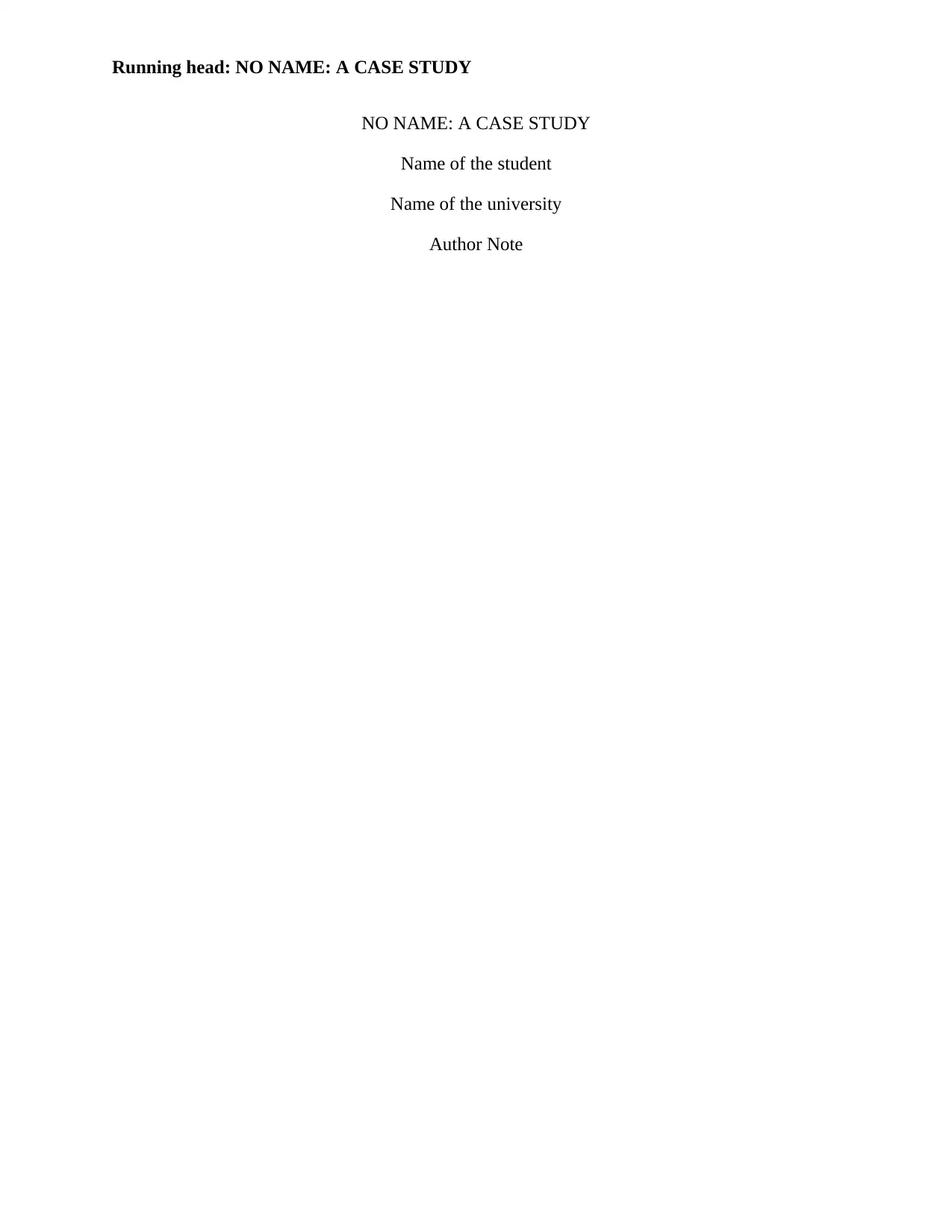
Running head: NO NAME: A CASE STUDY
NO NAME: A CASE STUDY
Name of the student
Name of the university
Author Note
NO NAME: A CASE STUDY
Name of the student
Name of the university
Author Note
Paraphrase This Document
Need a fresh take? Get an instant paraphrase of this document with our AI Paraphraser
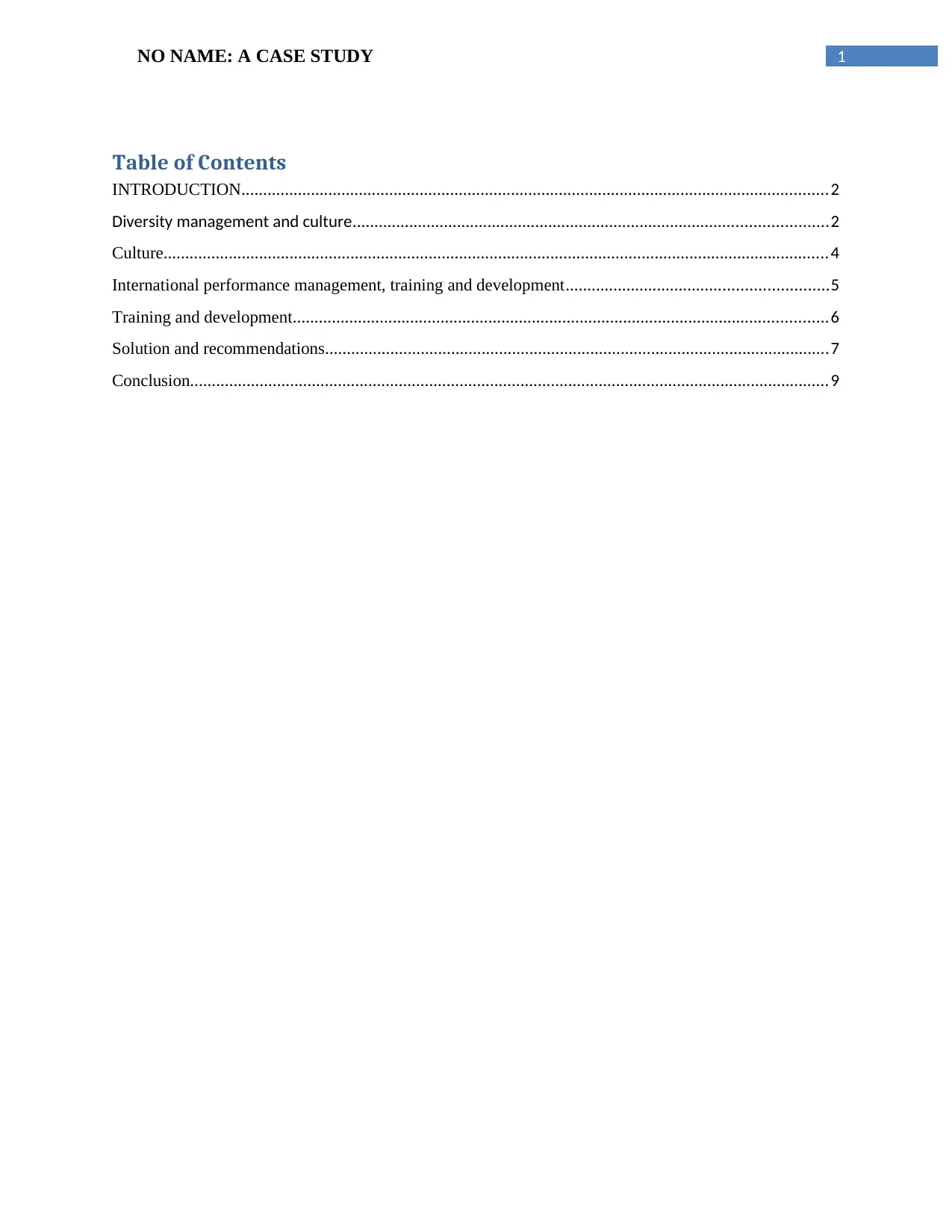
1NO NAME: A CASE STUDY
Table of Contents
INTRODUCTION.......................................................................................................................................2
Diversity management and culture.............................................................................................................2
Culture.........................................................................................................................................................4
International performance management, training and development............................................................5
Training and development...........................................................................................................................6
Solution and recommendations....................................................................................................................7
Conclusion...................................................................................................................................................9
Table of Contents
INTRODUCTION.......................................................................................................................................2
Diversity management and culture.............................................................................................................2
Culture.........................................................................................................................................................4
International performance management, training and development............................................................5
Training and development...........................................................................................................................6
Solution and recommendations....................................................................................................................7
Conclusion...................................................................................................................................................9
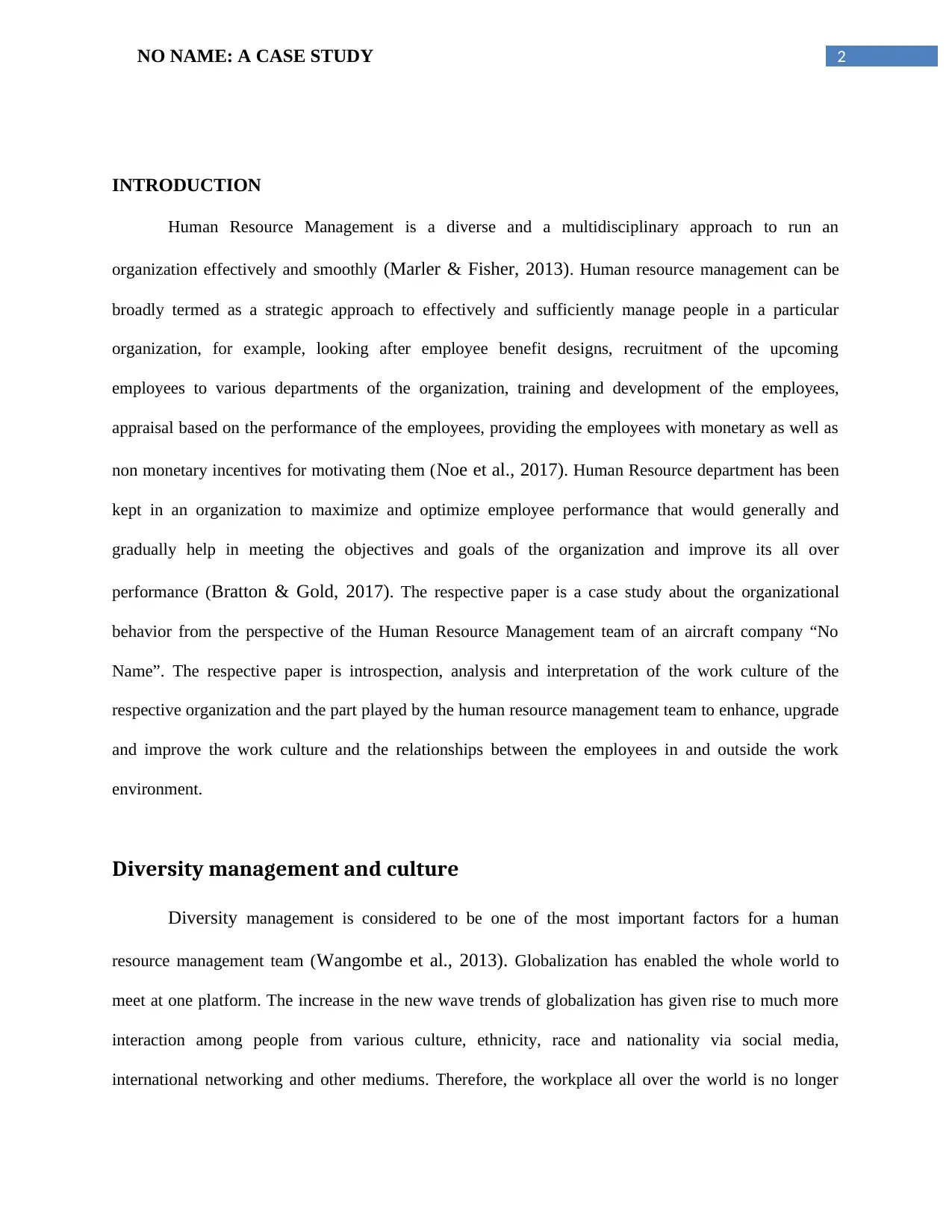
2NO NAME: A CASE STUDY
INTRODUCTION
Human Resource Management is a diverse and a multidisciplinary approach to run an
organization effectively and smoothly (Marler & Fisher, 2013). Human resource management can be
broadly termed as a strategic approach to effectively and sufficiently manage people in a particular
organization, for example, looking after employee benefit designs, recruitment of the upcoming
employees to various departments of the organization, training and development of the employees,
appraisal based on the performance of the employees, providing the employees with monetary as well as
non monetary incentives for motivating them (Noe et al., 2017). Human Resource department has been
kept in an organization to maximize and optimize employee performance that would generally and
gradually help in meeting the objectives and goals of the organization and improve its all over
performance (Bratton & Gold, 2017). The respective paper is a case study about the organizational
behavior from the perspective of the Human Resource Management team of an aircraft company “No
Name”. The respective paper is introspection, analysis and interpretation of the work culture of the
respective organization and the part played by the human resource management team to enhance, upgrade
and improve the work culture and the relationships between the employees in and outside the work
environment.
Diversity management and culture
Diversity management is considered to be one of the most important factors for a human
resource management team (Wangombe et al., 2013). Globalization has enabled the whole world to
meet at one platform. The increase in the new wave trends of globalization has given rise to much more
interaction among people from various culture, ethnicity, race and nationality via social media,
international networking and other mediums. Therefore, the workplace all over the world is no longer
INTRODUCTION
Human Resource Management is a diverse and a multidisciplinary approach to run an
organization effectively and smoothly (Marler & Fisher, 2013). Human resource management can be
broadly termed as a strategic approach to effectively and sufficiently manage people in a particular
organization, for example, looking after employee benefit designs, recruitment of the upcoming
employees to various departments of the organization, training and development of the employees,
appraisal based on the performance of the employees, providing the employees with monetary as well as
non monetary incentives for motivating them (Noe et al., 2017). Human Resource department has been
kept in an organization to maximize and optimize employee performance that would generally and
gradually help in meeting the objectives and goals of the organization and improve its all over
performance (Bratton & Gold, 2017). The respective paper is a case study about the organizational
behavior from the perspective of the Human Resource Management team of an aircraft company “No
Name”. The respective paper is introspection, analysis and interpretation of the work culture of the
respective organization and the part played by the human resource management team to enhance, upgrade
and improve the work culture and the relationships between the employees in and outside the work
environment.
Diversity management and culture
Diversity management is considered to be one of the most important factors for a human
resource management team (Wangombe et al., 2013). Globalization has enabled the whole world to
meet at one platform. The increase in the new wave trends of globalization has given rise to much more
interaction among people from various culture, ethnicity, race and nationality via social media,
international networking and other mediums. Therefore, the workplace all over the world is no longer
⊘ This is a preview!⊘
Do you want full access?
Subscribe today to unlock all pages.

Trusted by 1+ million students worldwide
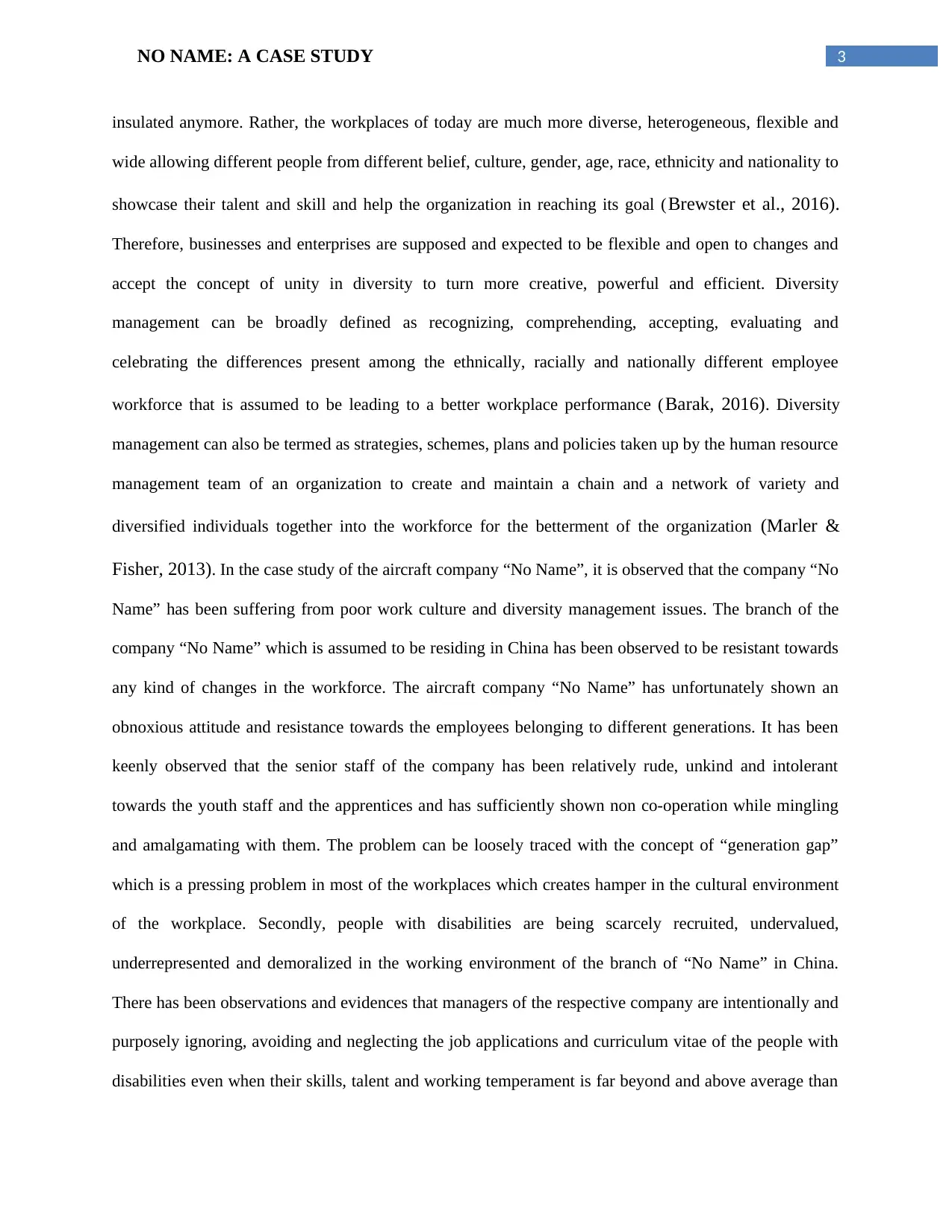
3NO NAME: A CASE STUDY
insulated anymore. Rather, the workplaces of today are much more diverse, heterogeneous, flexible and
wide allowing different people from different belief, culture, gender, age, race, ethnicity and nationality to
showcase their talent and skill and help the organization in reaching its goal (Brewster et al., 2016).
Therefore, businesses and enterprises are supposed and expected to be flexible and open to changes and
accept the concept of unity in diversity to turn more creative, powerful and efficient. Diversity
management can be broadly defined as recognizing, comprehending, accepting, evaluating and
celebrating the differences present among the ethnically, racially and nationally different employee
workforce that is assumed to be leading to a better workplace performance (Barak, 2016). Diversity
management can also be termed as strategies, schemes, plans and policies taken up by the human resource
management team of an organization to create and maintain a chain and a network of variety and
diversified individuals together into the workforce for the betterment of the organization (Marler &
Fisher, 2013). In the case study of the aircraft company “No Name”, it is observed that the company “No
Name” has been suffering from poor work culture and diversity management issues. The branch of the
company “No Name” which is assumed to be residing in China has been observed to be resistant towards
any kind of changes in the workforce. The aircraft company “No Name” has unfortunately shown an
obnoxious attitude and resistance towards the employees belonging to different generations. It has been
keenly observed that the senior staff of the company has been relatively rude, unkind and intolerant
towards the youth staff and the apprentices and has sufficiently shown non co-operation while mingling
and amalgamating with them. The problem can be loosely traced with the concept of “generation gap”
which is a pressing problem in most of the workplaces which creates hamper in the cultural environment
of the workplace. Secondly, people with disabilities are being scarcely recruited, undervalued,
underrepresented and demoralized in the working environment of the branch of “No Name” in China.
There has been observations and evidences that managers of the respective company are intentionally and
purposely ignoring, avoiding and neglecting the job applications and curriculum vitae of the people with
disabilities even when their skills, talent and working temperament is far beyond and above average than
insulated anymore. Rather, the workplaces of today are much more diverse, heterogeneous, flexible and
wide allowing different people from different belief, culture, gender, age, race, ethnicity and nationality to
showcase their talent and skill and help the organization in reaching its goal (Brewster et al., 2016).
Therefore, businesses and enterprises are supposed and expected to be flexible and open to changes and
accept the concept of unity in diversity to turn more creative, powerful and efficient. Diversity
management can be broadly defined as recognizing, comprehending, accepting, evaluating and
celebrating the differences present among the ethnically, racially and nationally different employee
workforce that is assumed to be leading to a better workplace performance (Barak, 2016). Diversity
management can also be termed as strategies, schemes, plans and policies taken up by the human resource
management team of an organization to create and maintain a chain and a network of variety and
diversified individuals together into the workforce for the betterment of the organization (Marler &
Fisher, 2013). In the case study of the aircraft company “No Name”, it is observed that the company “No
Name” has been suffering from poor work culture and diversity management issues. The branch of the
company “No Name” which is assumed to be residing in China has been observed to be resistant towards
any kind of changes in the workforce. The aircraft company “No Name” has unfortunately shown an
obnoxious attitude and resistance towards the employees belonging to different generations. It has been
keenly observed that the senior staff of the company has been relatively rude, unkind and intolerant
towards the youth staff and the apprentices and has sufficiently shown non co-operation while mingling
and amalgamating with them. The problem can be loosely traced with the concept of “generation gap”
which is a pressing problem in most of the workplaces which creates hamper in the cultural environment
of the workplace. Secondly, people with disabilities are being scarcely recruited, undervalued,
underrepresented and demoralized in the working environment of the branch of “No Name” in China.
There has been observations and evidences that managers of the respective company are intentionally and
purposely ignoring, avoiding and neglecting the job applications and curriculum vitae of the people with
disabilities even when their skills, talent and working temperament is far beyond and above average than
Paraphrase This Document
Need a fresh take? Get an instant paraphrase of this document with our AI Paraphraser
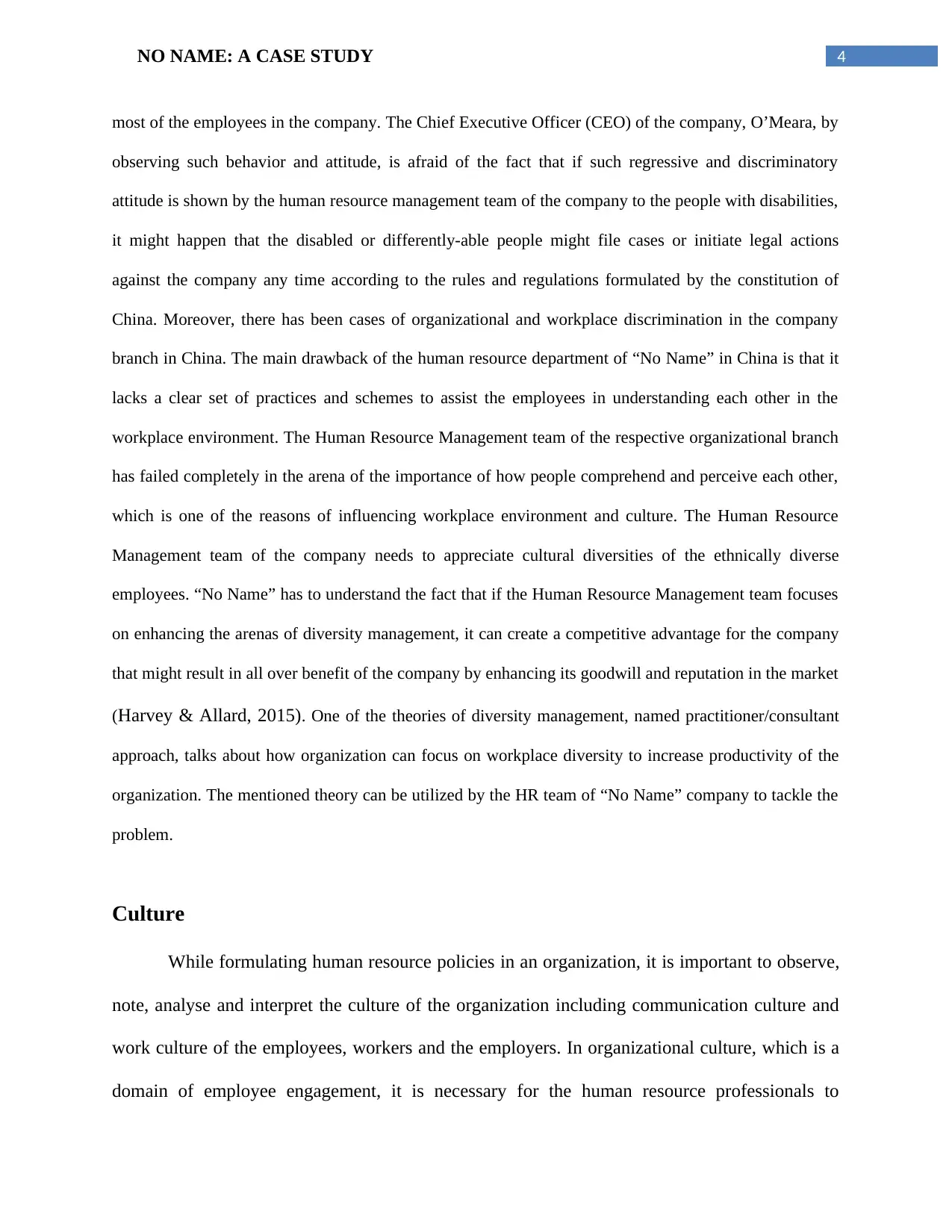
4NO NAME: A CASE STUDY
most of the employees in the company. The Chief Executive Officer (CEO) of the company, O’Meara, by
observing such behavior and attitude, is afraid of the fact that if such regressive and discriminatory
attitude is shown by the human resource management team of the company to the people with disabilities,
it might happen that the disabled or differently-able people might file cases or initiate legal actions
against the company any time according to the rules and regulations formulated by the constitution of
China. Moreover, there has been cases of organizational and workplace discrimination in the company
branch in China. The main drawback of the human resource department of “No Name” in China is that it
lacks a clear set of practices and schemes to assist the employees in understanding each other in the
workplace environment. The Human Resource Management team of the respective organizational branch
has failed completely in the arena of the importance of how people comprehend and perceive each other,
which is one of the reasons of influencing workplace environment and culture. The Human Resource
Management team of the company needs to appreciate cultural diversities of the ethnically diverse
employees. “No Name” has to understand the fact that if the Human Resource Management team focuses
on enhancing the arenas of diversity management, it can create a competitive advantage for the company
that might result in all over benefit of the company by enhancing its goodwill and reputation in the market
(Harvey & Allard, 2015). One of the theories of diversity management, named practitioner/consultant
approach, talks about how organization can focus on workplace diversity to increase productivity of the
organization. The mentioned theory can be utilized by the HR team of “No Name” company to tackle the
problem.
Culture
While formulating human resource policies in an organization, it is important to observe,
note, analyse and interpret the culture of the organization including communication culture and
work culture of the employees, workers and the employers. In organizational culture, which is a
domain of employee engagement, it is necessary for the human resource professionals to
most of the employees in the company. The Chief Executive Officer (CEO) of the company, O’Meara, by
observing such behavior and attitude, is afraid of the fact that if such regressive and discriminatory
attitude is shown by the human resource management team of the company to the people with disabilities,
it might happen that the disabled or differently-able people might file cases or initiate legal actions
against the company any time according to the rules and regulations formulated by the constitution of
China. Moreover, there has been cases of organizational and workplace discrimination in the company
branch in China. The main drawback of the human resource department of “No Name” in China is that it
lacks a clear set of practices and schemes to assist the employees in understanding each other in the
workplace environment. The Human Resource Management team of the respective organizational branch
has failed completely in the arena of the importance of how people comprehend and perceive each other,
which is one of the reasons of influencing workplace environment and culture. The Human Resource
Management team of the company needs to appreciate cultural diversities of the ethnically diverse
employees. “No Name” has to understand the fact that if the Human Resource Management team focuses
on enhancing the arenas of diversity management, it can create a competitive advantage for the company
that might result in all over benefit of the company by enhancing its goodwill and reputation in the market
(Harvey & Allard, 2015). One of the theories of diversity management, named practitioner/consultant
approach, talks about how organization can focus on workplace diversity to increase productivity of the
organization. The mentioned theory can be utilized by the HR team of “No Name” company to tackle the
problem.
Culture
While formulating human resource policies in an organization, it is important to observe,
note, analyse and interpret the culture of the organization including communication culture and
work culture of the employees, workers and the employers. In organizational culture, which is a
domain of employee engagement, it is necessary for the human resource professionals to
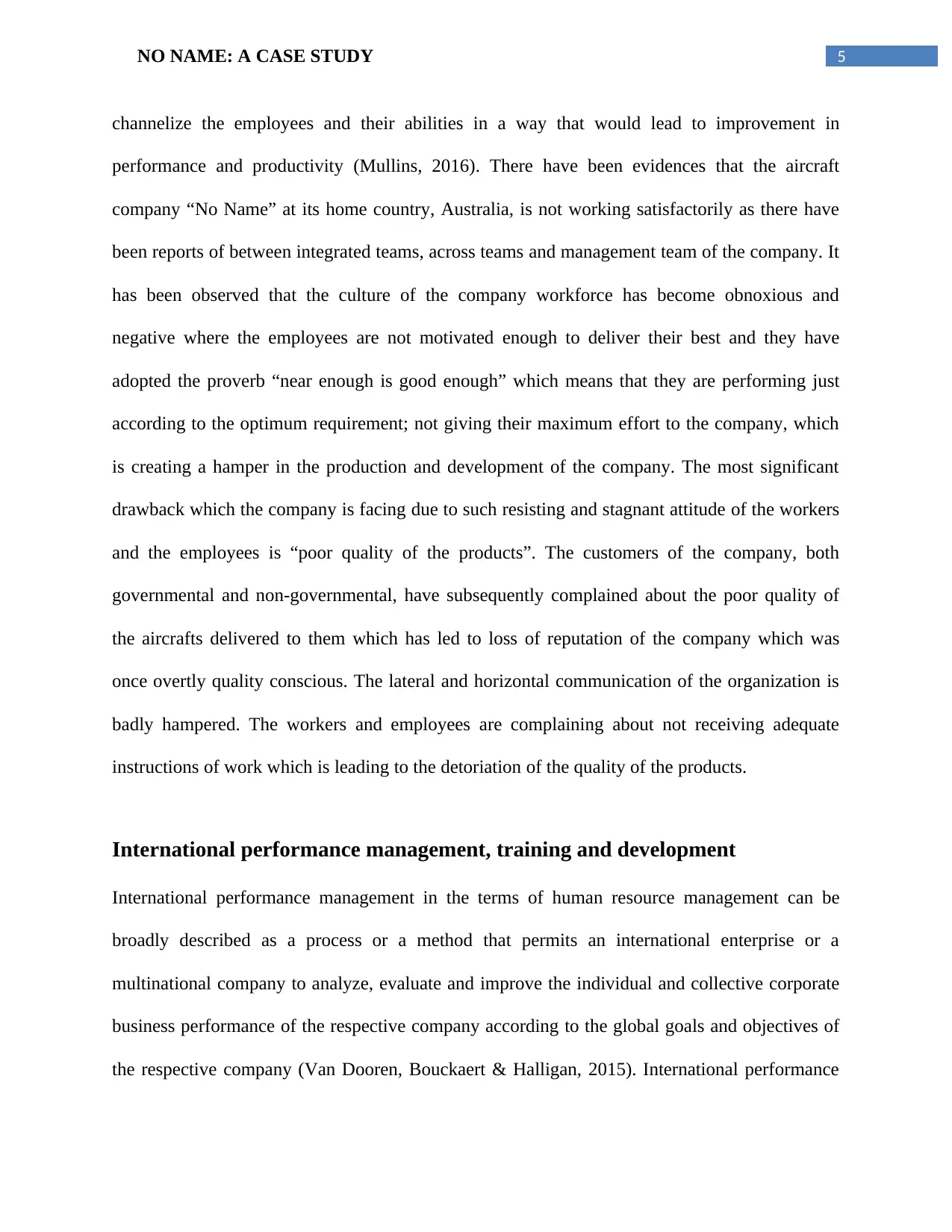
5NO NAME: A CASE STUDY
channelize the employees and their abilities in a way that would lead to improvement in
performance and productivity (Mullins, 2016). There have been evidences that the aircraft
company “No Name” at its home country, Australia, is not working satisfactorily as there have
been reports of between integrated teams, across teams and management team of the company. It
has been observed that the culture of the company workforce has become obnoxious and
negative where the employees are not motivated enough to deliver their best and they have
adopted the proverb “near enough is good enough” which means that they are performing just
according to the optimum requirement; not giving their maximum effort to the company, which
is creating a hamper in the production and development of the company. The most significant
drawback which the company is facing due to such resisting and stagnant attitude of the workers
and the employees is “poor quality of the products”. The customers of the company, both
governmental and non-governmental, have subsequently complained about the poor quality of
the aircrafts delivered to them which has led to loss of reputation of the company which was
once overtly quality conscious. The lateral and horizontal communication of the organization is
badly hampered. The workers and employees are complaining about not receiving adequate
instructions of work which is leading to the detoriation of the quality of the products.
International performance management, training and development
International performance management in the terms of human resource management can be
broadly described as a process or a method that permits an international enterprise or a
multinational company to analyze, evaluate and improve the individual and collective corporate
business performance of the respective company according to the global goals and objectives of
the respective company (Van Dooren, Bouckaert & Halligan, 2015). International performance
channelize the employees and their abilities in a way that would lead to improvement in
performance and productivity (Mullins, 2016). There have been evidences that the aircraft
company “No Name” at its home country, Australia, is not working satisfactorily as there have
been reports of between integrated teams, across teams and management team of the company. It
has been observed that the culture of the company workforce has become obnoxious and
negative where the employees are not motivated enough to deliver their best and they have
adopted the proverb “near enough is good enough” which means that they are performing just
according to the optimum requirement; not giving their maximum effort to the company, which
is creating a hamper in the production and development of the company. The most significant
drawback which the company is facing due to such resisting and stagnant attitude of the workers
and the employees is “poor quality of the products”. The customers of the company, both
governmental and non-governmental, have subsequently complained about the poor quality of
the aircrafts delivered to them which has led to loss of reputation of the company which was
once overtly quality conscious. The lateral and horizontal communication of the organization is
badly hampered. The workers and employees are complaining about not receiving adequate
instructions of work which is leading to the detoriation of the quality of the products.
International performance management, training and development
International performance management in the terms of human resource management can be
broadly described as a process or a method that permits an international enterprise or a
multinational company to analyze, evaluate and improve the individual and collective corporate
business performance of the respective company according to the global goals and objectives of
the respective company (Van Dooren, Bouckaert & Halligan, 2015). International performance
⊘ This is a preview!⊘
Do you want full access?
Subscribe today to unlock all pages.

Trusted by 1+ million students worldwide
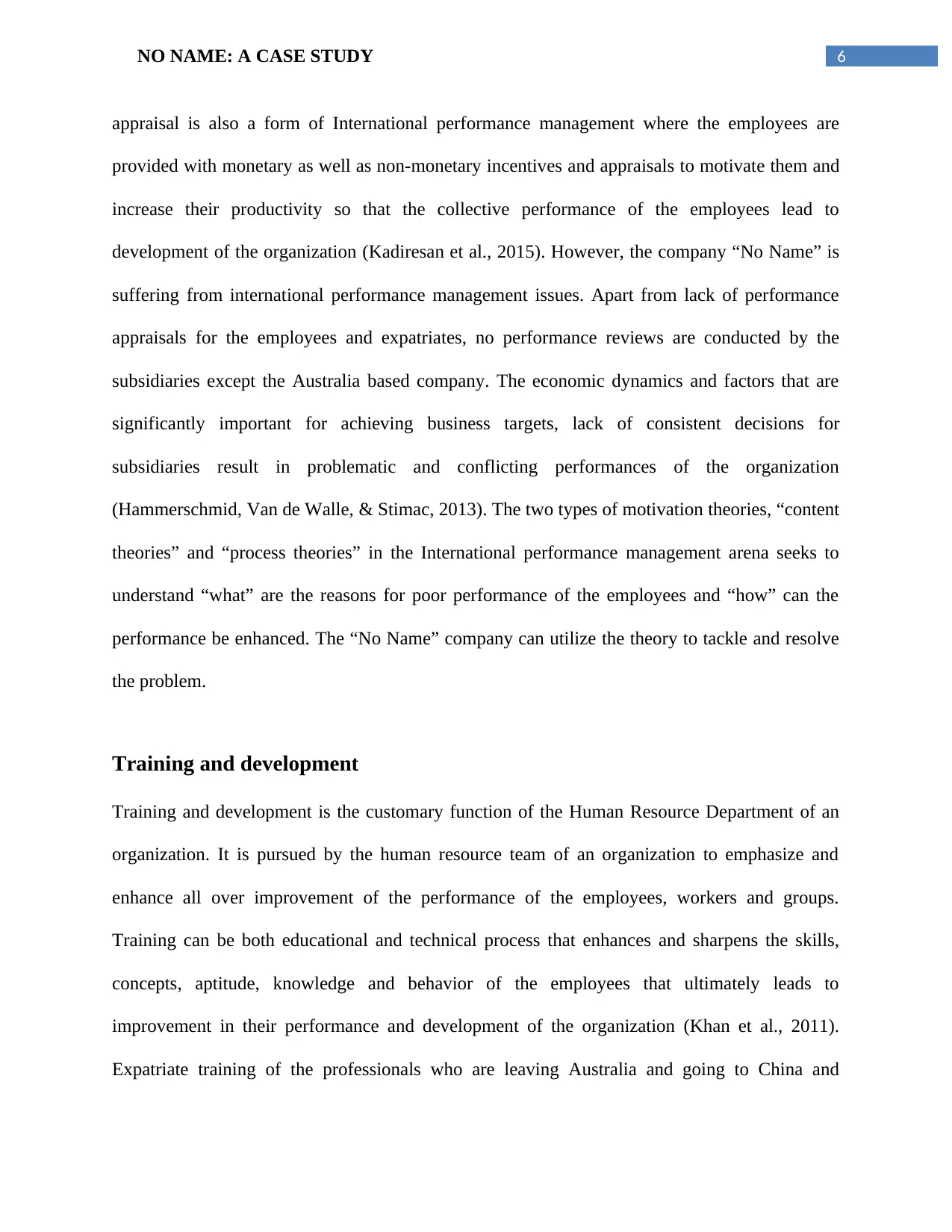
6NO NAME: A CASE STUDY
appraisal is also a form of International performance management where the employees are
provided with monetary as well as non-monetary incentives and appraisals to motivate them and
increase their productivity so that the collective performance of the employees lead to
development of the organization (Kadiresan et al., 2015). However, the company “No Name” is
suffering from international performance management issues. Apart from lack of performance
appraisals for the employees and expatriates, no performance reviews are conducted by the
subsidiaries except the Australia based company. The economic dynamics and factors that are
significantly important for achieving business targets, lack of consistent decisions for
subsidiaries result in problematic and conflicting performances of the organization
(Hammerschmid, Van de Walle, & Stimac, 2013). The two types of motivation theories, “content
theories” and “process theories” in the International performance management arena seeks to
understand “what” are the reasons for poor performance of the employees and “how” can the
performance be enhanced. The “No Name” company can utilize the theory to tackle and resolve
the problem.
Training and development
Training and development is the customary function of the Human Resource Department of an
organization. It is pursued by the human resource team of an organization to emphasize and
enhance all over improvement of the performance of the employees, workers and groups.
Training can be both educational and technical process that enhances and sharpens the skills,
concepts, aptitude, knowledge and behavior of the employees that ultimately leads to
improvement in their performance and development of the organization (Khan et al., 2011).
Expatriate training of the professionals who are leaving Australia and going to China and
appraisal is also a form of International performance management where the employees are
provided with monetary as well as non-monetary incentives and appraisals to motivate them and
increase their productivity so that the collective performance of the employees lead to
development of the organization (Kadiresan et al., 2015). However, the company “No Name” is
suffering from international performance management issues. Apart from lack of performance
appraisals for the employees and expatriates, no performance reviews are conducted by the
subsidiaries except the Australia based company. The economic dynamics and factors that are
significantly important for achieving business targets, lack of consistent decisions for
subsidiaries result in problematic and conflicting performances of the organization
(Hammerschmid, Van de Walle, & Stimac, 2013). The two types of motivation theories, “content
theories” and “process theories” in the International performance management arena seeks to
understand “what” are the reasons for poor performance of the employees and “how” can the
performance be enhanced. The “No Name” company can utilize the theory to tackle and resolve
the problem.
Training and development
Training and development is the customary function of the Human Resource Department of an
organization. It is pursued by the human resource team of an organization to emphasize and
enhance all over improvement of the performance of the employees, workers and groups.
Training can be both educational and technical process that enhances and sharpens the skills,
concepts, aptitude, knowledge and behavior of the employees that ultimately leads to
improvement in their performance and development of the organization (Khan et al., 2011).
Expatriate training of the professionals who are leaving Australia and going to China and
Paraphrase This Document
Need a fresh take? Get an instant paraphrase of this document with our AI Paraphraser
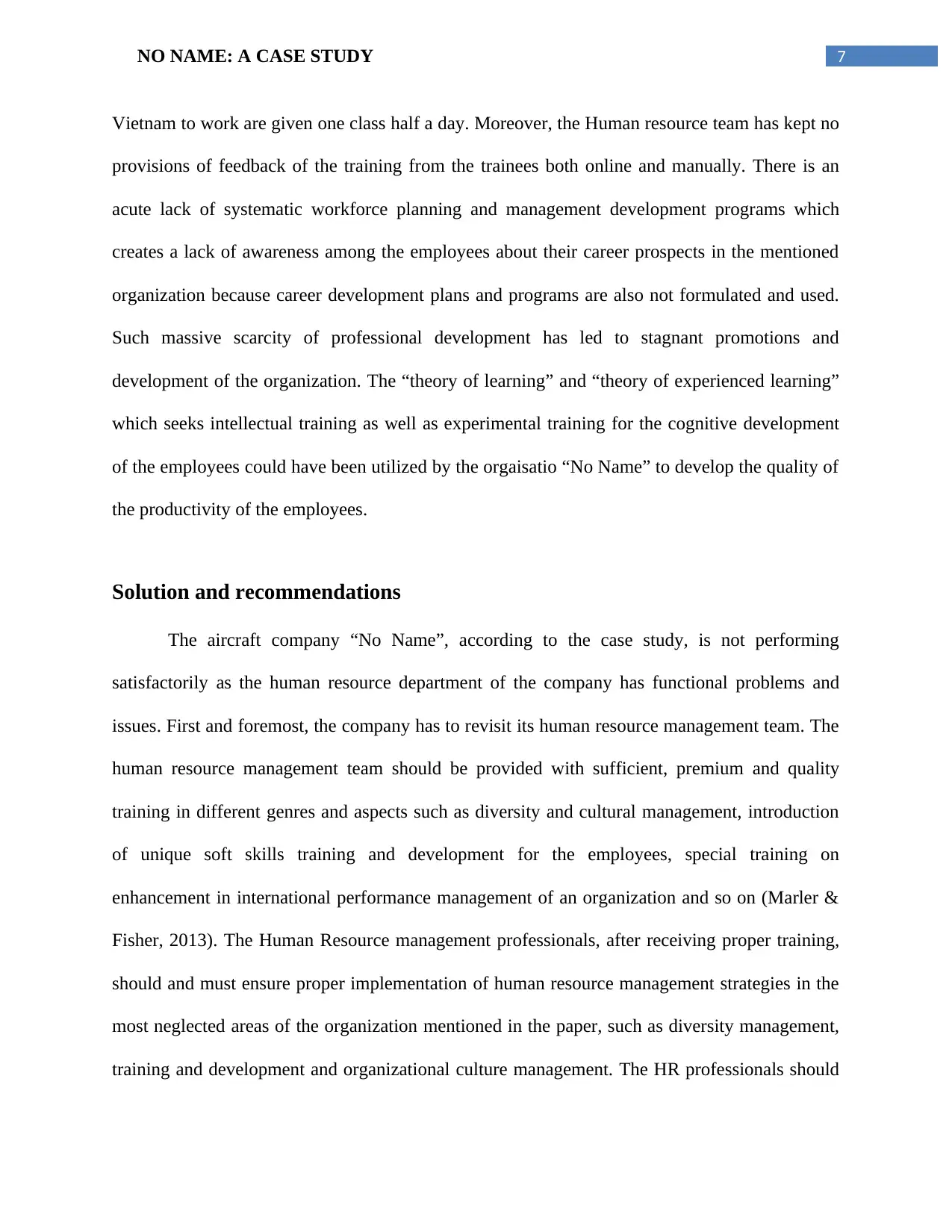
7NO NAME: A CASE STUDY
Vietnam to work are given one class half a day. Moreover, the Human resource team has kept no
provisions of feedback of the training from the trainees both online and manually. There is an
acute lack of systematic workforce planning and management development programs which
creates a lack of awareness among the employees about their career prospects in the mentioned
organization because career development plans and programs are also not formulated and used.
Such massive scarcity of professional development has led to stagnant promotions and
development of the organization. The “theory of learning” and “theory of experienced learning”
which seeks intellectual training as well as experimental training for the cognitive development
of the employees could have been utilized by the orgaisatio “No Name” to develop the quality of
the productivity of the employees.
Solution and recommendations
The aircraft company “No Name”, according to the case study, is not performing
satisfactorily as the human resource department of the company has functional problems and
issues. First and foremost, the company has to revisit its human resource management team. The
human resource management team should be provided with sufficient, premium and quality
training in different genres and aspects such as diversity and cultural management, introduction
of unique soft skills training and development for the employees, special training on
enhancement in international performance management of an organization and so on (Marler &
Fisher, 2013). The Human Resource management professionals, after receiving proper training,
should and must ensure proper implementation of human resource management strategies in the
most neglected areas of the organization mentioned in the paper, such as diversity management,
training and development and organizational culture management. The HR professionals should
Vietnam to work are given one class half a day. Moreover, the Human resource team has kept no
provisions of feedback of the training from the trainees both online and manually. There is an
acute lack of systematic workforce planning and management development programs which
creates a lack of awareness among the employees about their career prospects in the mentioned
organization because career development plans and programs are also not formulated and used.
Such massive scarcity of professional development has led to stagnant promotions and
development of the organization. The “theory of learning” and “theory of experienced learning”
which seeks intellectual training as well as experimental training for the cognitive development
of the employees could have been utilized by the orgaisatio “No Name” to develop the quality of
the productivity of the employees.
Solution and recommendations
The aircraft company “No Name”, according to the case study, is not performing
satisfactorily as the human resource department of the company has functional problems and
issues. First and foremost, the company has to revisit its human resource management team. The
human resource management team should be provided with sufficient, premium and quality
training in different genres and aspects such as diversity and cultural management, introduction
of unique soft skills training and development for the employees, special training on
enhancement in international performance management of an organization and so on (Marler &
Fisher, 2013). The Human Resource management professionals, after receiving proper training,
should and must ensure proper implementation of human resource management strategies in the
most neglected areas of the organization mentioned in the paper, such as diversity management,
training and development and organizational culture management. The HR professionals should
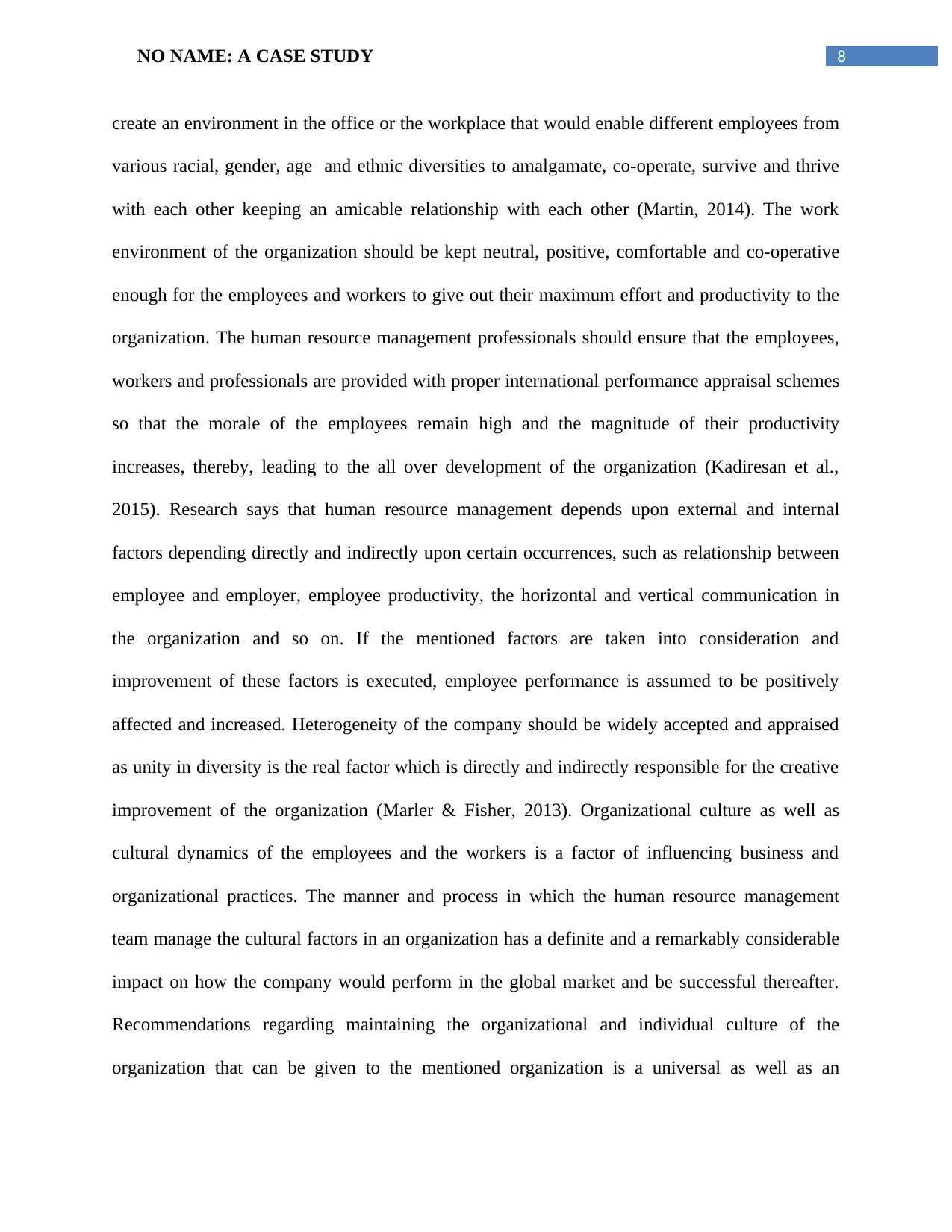
8NO NAME: A CASE STUDY
create an environment in the office or the workplace that would enable different employees from
various racial, gender, age and ethnic diversities to amalgamate, co-operate, survive and thrive
with each other keeping an amicable relationship with each other (Martin, 2014). The work
environment of the organization should be kept neutral, positive, comfortable and co-operative
enough for the employees and workers to give out their maximum effort and productivity to the
organization. The human resource management professionals should ensure that the employees,
workers and professionals are provided with proper international performance appraisal schemes
so that the morale of the employees remain high and the magnitude of their productivity
increases, thereby, leading to the all over development of the organization (Kadiresan et al.,
2015). Research says that human resource management depends upon external and internal
factors depending directly and indirectly upon certain occurrences, such as relationship between
employee and employer, employee productivity, the horizontal and vertical communication in
the organization and so on. If the mentioned factors are taken into consideration and
improvement of these factors is executed, employee performance is assumed to be positively
affected and increased. Heterogeneity of the company should be widely accepted and appraised
as unity in diversity is the real factor which is directly and indirectly responsible for the creative
improvement of the organization (Marler & Fisher, 2013). Organizational culture as well as
cultural dynamics of the employees and the workers is a factor of influencing business and
organizational practices. The manner and process in which the human resource management
team manage the cultural factors in an organization has a definite and a remarkably considerable
impact on how the company would perform in the global market and be successful thereafter.
Recommendations regarding maintaining the organizational and individual culture of the
organization that can be given to the mentioned organization is a universal as well as an
create an environment in the office or the workplace that would enable different employees from
various racial, gender, age and ethnic diversities to amalgamate, co-operate, survive and thrive
with each other keeping an amicable relationship with each other (Martin, 2014). The work
environment of the organization should be kept neutral, positive, comfortable and co-operative
enough for the employees and workers to give out their maximum effort and productivity to the
organization. The human resource management professionals should ensure that the employees,
workers and professionals are provided with proper international performance appraisal schemes
so that the morale of the employees remain high and the magnitude of their productivity
increases, thereby, leading to the all over development of the organization (Kadiresan et al.,
2015). Research says that human resource management depends upon external and internal
factors depending directly and indirectly upon certain occurrences, such as relationship between
employee and employer, employee productivity, the horizontal and vertical communication in
the organization and so on. If the mentioned factors are taken into consideration and
improvement of these factors is executed, employee performance is assumed to be positively
affected and increased. Heterogeneity of the company should be widely accepted and appraised
as unity in diversity is the real factor which is directly and indirectly responsible for the creative
improvement of the organization (Marler & Fisher, 2013). Organizational culture as well as
cultural dynamics of the employees and the workers is a factor of influencing business and
organizational practices. The manner and process in which the human resource management
team manage the cultural factors in an organization has a definite and a remarkably considerable
impact on how the company would perform in the global market and be successful thereafter.
Recommendations regarding maintaining the organizational and individual culture of the
organization that can be given to the mentioned organization is a universal as well as an
⊘ This is a preview!⊘
Do you want full access?
Subscribe today to unlock all pages.

Trusted by 1+ million students worldwide
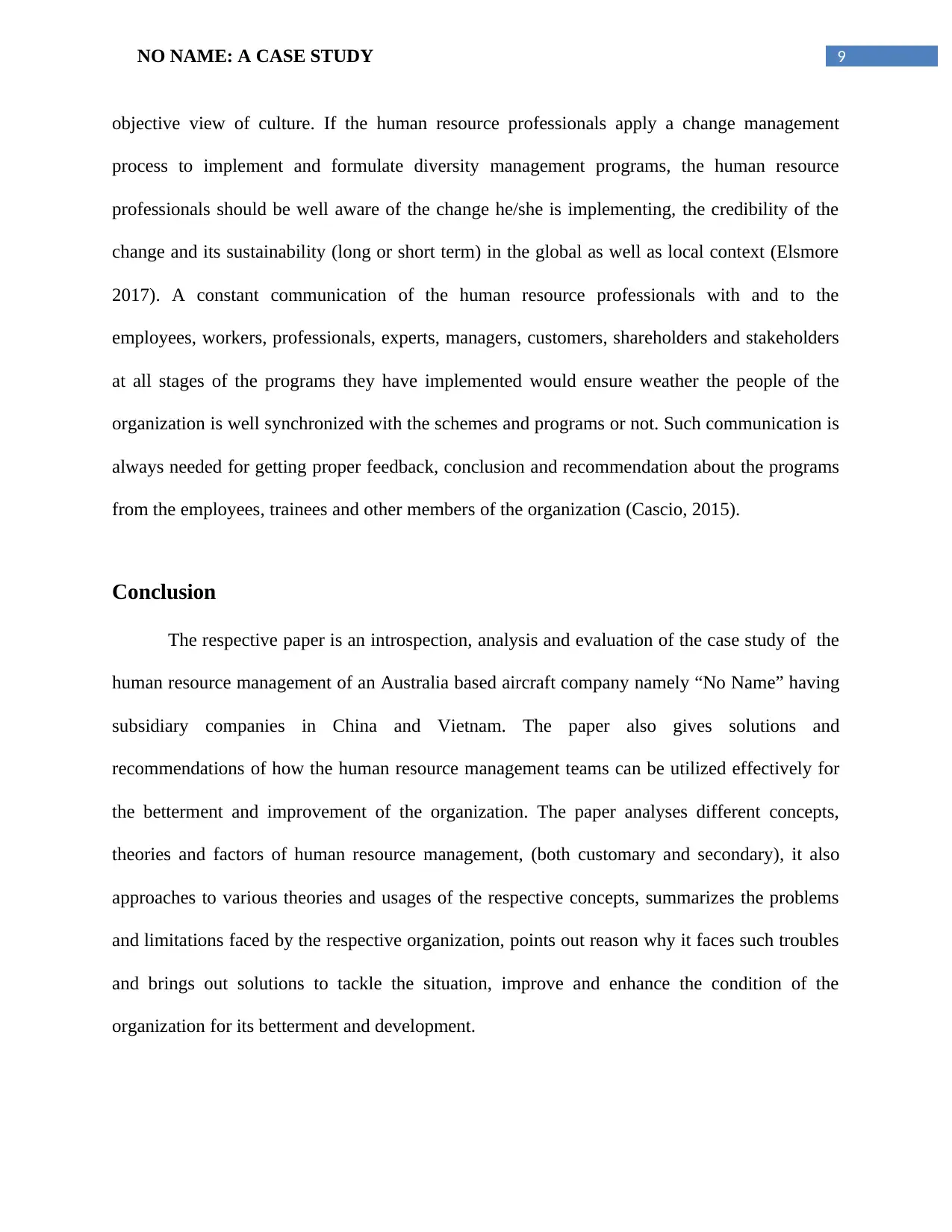
9NO NAME: A CASE STUDY
objective view of culture. If the human resource professionals apply a change management
process to implement and formulate diversity management programs, the human resource
professionals should be well aware of the change he/she is implementing, the credibility of the
change and its sustainability (long or short term) in the global as well as local context (Elsmore
2017). A constant communication of the human resource professionals with and to the
employees, workers, professionals, experts, managers, customers, shareholders and stakeholders
at all stages of the programs they have implemented would ensure weather the people of the
organization is well synchronized with the schemes and programs or not. Such communication is
always needed for getting proper feedback, conclusion and recommendation about the programs
from the employees, trainees and other members of the organization (Cascio, 2015).
Conclusion
The respective paper is an introspection, analysis and evaluation of the case study of the
human resource management of an Australia based aircraft company namely “No Name” having
subsidiary companies in China and Vietnam. The paper also gives solutions and
recommendations of how the human resource management teams can be utilized effectively for
the betterment and improvement of the organization. The paper analyses different concepts,
theories and factors of human resource management, (both customary and secondary), it also
approaches to various theories and usages of the respective concepts, summarizes the problems
and limitations faced by the respective organization, points out reason why it faces such troubles
and brings out solutions to tackle the situation, improve and enhance the condition of the
organization for its betterment and development.
objective view of culture. If the human resource professionals apply a change management
process to implement and formulate diversity management programs, the human resource
professionals should be well aware of the change he/she is implementing, the credibility of the
change and its sustainability (long or short term) in the global as well as local context (Elsmore
2017). A constant communication of the human resource professionals with and to the
employees, workers, professionals, experts, managers, customers, shareholders and stakeholders
at all stages of the programs they have implemented would ensure weather the people of the
organization is well synchronized with the schemes and programs or not. Such communication is
always needed for getting proper feedback, conclusion and recommendation about the programs
from the employees, trainees and other members of the organization (Cascio, 2015).
Conclusion
The respective paper is an introspection, analysis and evaluation of the case study of the
human resource management of an Australia based aircraft company namely “No Name” having
subsidiary companies in China and Vietnam. The paper also gives solutions and
recommendations of how the human resource management teams can be utilized effectively for
the betterment and improvement of the organization. The paper analyses different concepts,
theories and factors of human resource management, (both customary and secondary), it also
approaches to various theories and usages of the respective concepts, summarizes the problems
and limitations faced by the respective organization, points out reason why it faces such troubles
and brings out solutions to tackle the situation, improve and enhance the condition of the
organization for its betterment and development.
Paraphrase This Document
Need a fresh take? Get an instant paraphrase of this document with our AI Paraphraser
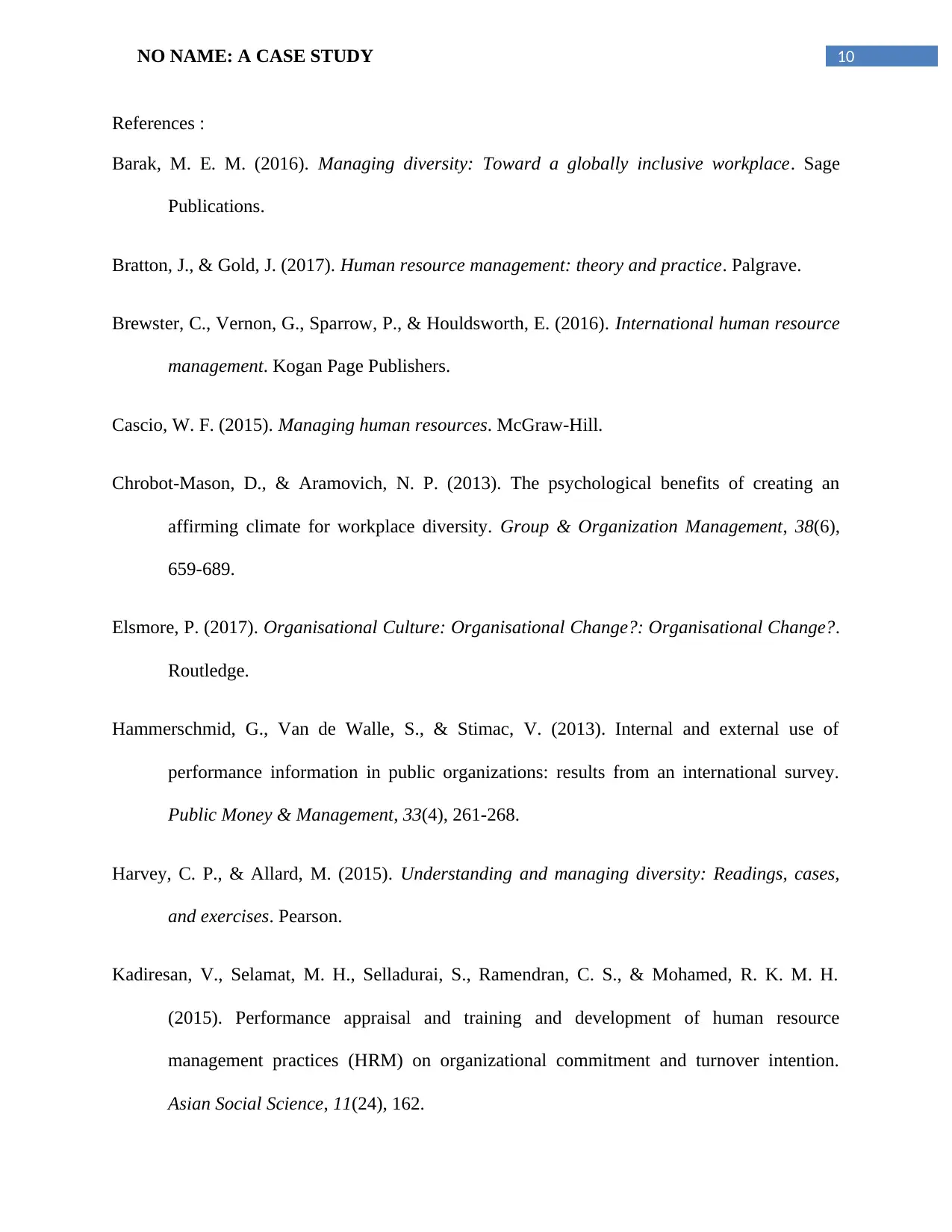
10NO NAME: A CASE STUDY
References :
Barak, M. E. M. (2016). Managing diversity: Toward a globally inclusive workplace. Sage
Publications.
Bratton, J., & Gold, J. (2017). Human resource management: theory and practice. Palgrave.
Brewster, C., Vernon, G., Sparrow, P., & Houldsworth, E. (2016). International human resource
management. Kogan Page Publishers.
Cascio, W. F. (2015). Managing human resources. McGraw-Hill.
Chrobot-Mason, D., & Aramovich, N. P. (2013). The psychological benefits of creating an
affirming climate for workplace diversity. Group & Organization Management, 38(6),
659-689.
Elsmore, P. (2017). Organisational Culture: Organisational Change?: Organisational Change?.
Routledge.
Hammerschmid, G., Van de Walle, S., & Stimac, V. (2013). Internal and external use of
performance information in public organizations: results from an international survey.
Public Money & Management, 33(4), 261-268.
Harvey, C. P., & Allard, M. (2015). Understanding and managing diversity: Readings, cases,
and exercises. Pearson.
Kadiresan, V., Selamat, M. H., Selladurai, S., Ramendran, C. S., & Mohamed, R. K. M. H.
(2015). Performance appraisal and training and development of human resource
management practices (HRM) on organizational commitment and turnover intention.
Asian Social Science, 11(24), 162.
References :
Barak, M. E. M. (2016). Managing diversity: Toward a globally inclusive workplace. Sage
Publications.
Bratton, J., & Gold, J. (2017). Human resource management: theory and practice. Palgrave.
Brewster, C., Vernon, G., Sparrow, P., & Houldsworth, E. (2016). International human resource
management. Kogan Page Publishers.
Cascio, W. F. (2015). Managing human resources. McGraw-Hill.
Chrobot-Mason, D., & Aramovich, N. P. (2013). The psychological benefits of creating an
affirming climate for workplace diversity. Group & Organization Management, 38(6),
659-689.
Elsmore, P. (2017). Organisational Culture: Organisational Change?: Organisational Change?.
Routledge.
Hammerschmid, G., Van de Walle, S., & Stimac, V. (2013). Internal and external use of
performance information in public organizations: results from an international survey.
Public Money & Management, 33(4), 261-268.
Harvey, C. P., & Allard, M. (2015). Understanding and managing diversity: Readings, cases,
and exercises. Pearson.
Kadiresan, V., Selamat, M. H., Selladurai, S., Ramendran, C. S., & Mohamed, R. K. M. H.
(2015). Performance appraisal and training and development of human resource
management practices (HRM) on organizational commitment and turnover intention.
Asian Social Science, 11(24), 162.
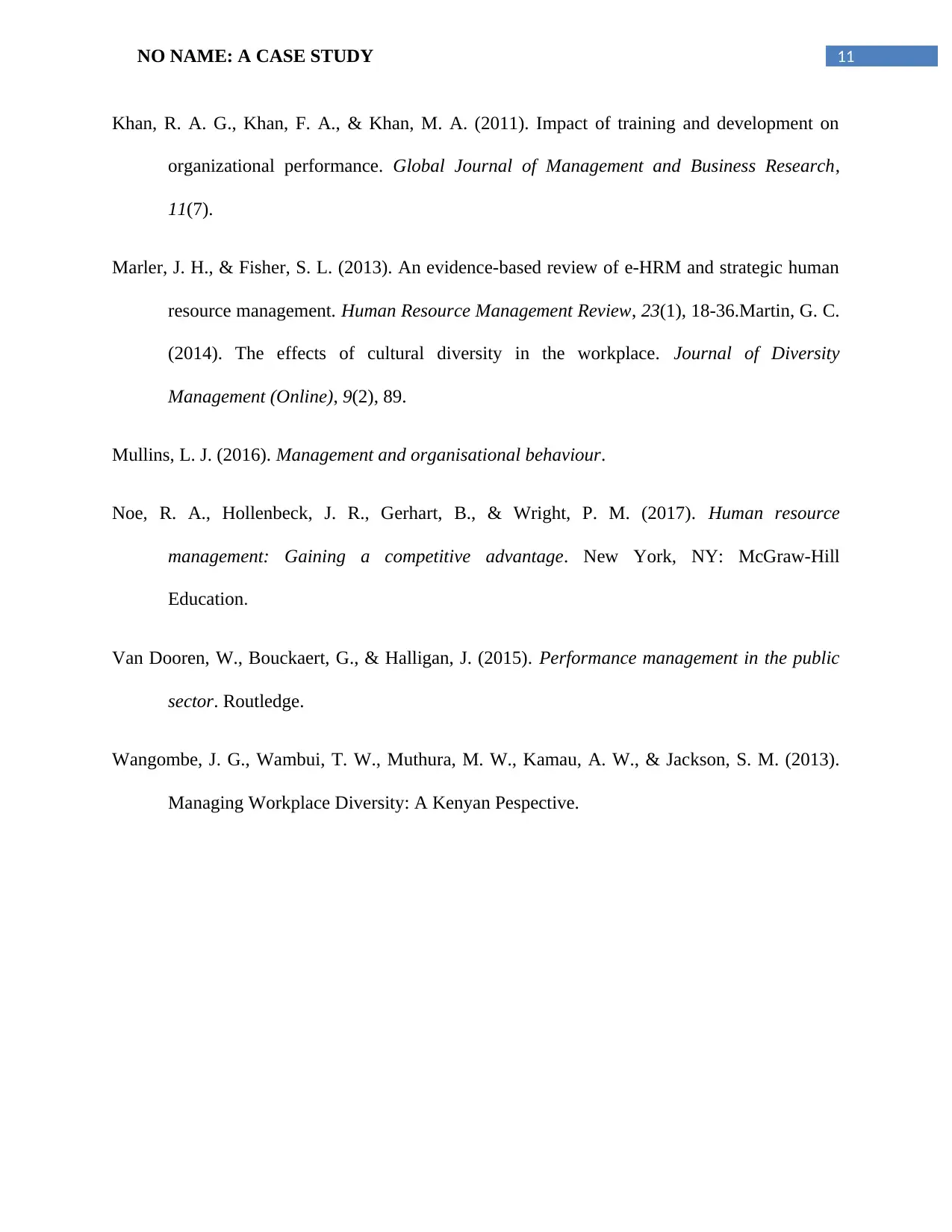
11NO NAME: A CASE STUDY
Khan, R. A. G., Khan, F. A., & Khan, M. A. (2011). Impact of training and development on
organizational performance. Global Journal of Management and Business Research,
11(7).
Marler, J. H., & Fisher, S. L. (2013). An evidence-based review of e-HRM and strategic human
resource management. Human Resource Management Review, 23(1), 18-36.Martin, G. C.
(2014). The effects of cultural diversity in the workplace. Journal of Diversity
Management (Online), 9(2), 89.
Mullins, L. J. (2016). Management and organisational behaviour.
Noe, R. A., Hollenbeck, J. R., Gerhart, B., & Wright, P. M. (2017). Human resource
management: Gaining a competitive advantage. New York, NY: McGraw-Hill
Education.
Van Dooren, W., Bouckaert, G., & Halligan, J. (2015). Performance management in the public
sector. Routledge.
Wangombe, J. G., Wambui, T. W., Muthura, M. W., Kamau, A. W., & Jackson, S. M. (2013).
Managing Workplace Diversity: A Kenyan Pespective.
Khan, R. A. G., Khan, F. A., & Khan, M. A. (2011). Impact of training and development on
organizational performance. Global Journal of Management and Business Research,
11(7).
Marler, J. H., & Fisher, S. L. (2013). An evidence-based review of e-HRM and strategic human
resource management. Human Resource Management Review, 23(1), 18-36.Martin, G. C.
(2014). The effects of cultural diversity in the workplace. Journal of Diversity
Management (Online), 9(2), 89.
Mullins, L. J. (2016). Management and organisational behaviour.
Noe, R. A., Hollenbeck, J. R., Gerhart, B., & Wright, P. M. (2017). Human resource
management: Gaining a competitive advantage. New York, NY: McGraw-Hill
Education.
Van Dooren, W., Bouckaert, G., & Halligan, J. (2015). Performance management in the public
sector. Routledge.
Wangombe, J. G., Wambui, T. W., Muthura, M. W., Kamau, A. W., & Jackson, S. M. (2013).
Managing Workplace Diversity: A Kenyan Pespective.
⊘ This is a preview!⊘
Do you want full access?
Subscribe today to unlock all pages.

Trusted by 1+ million students worldwide
1 out of 12
Related Documents
Your All-in-One AI-Powered Toolkit for Academic Success.
+13062052269
info@desklib.com
Available 24*7 on WhatsApp / Email
![[object Object]](/_next/static/media/star-bottom.7253800d.svg)
Unlock your academic potential
Copyright © 2020–2025 A2Z Services. All Rights Reserved. Developed and managed by ZUCOL.





